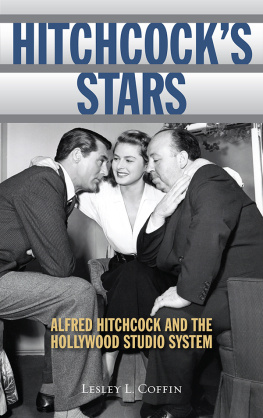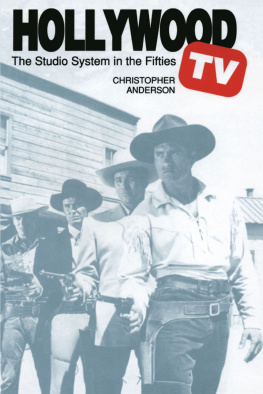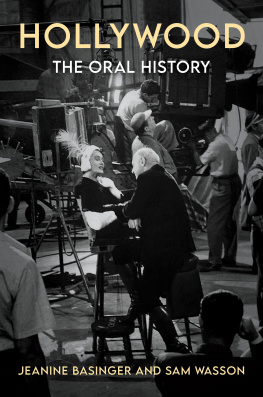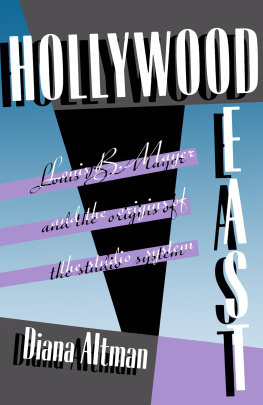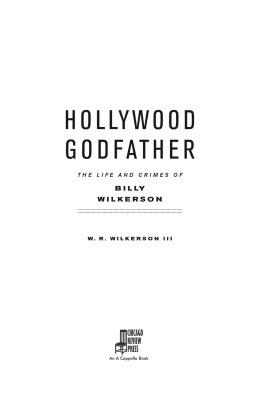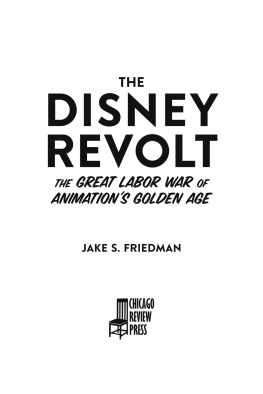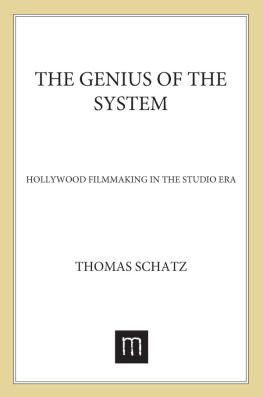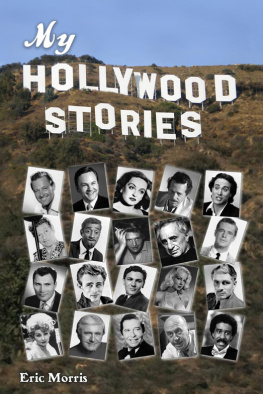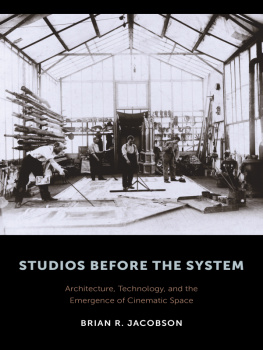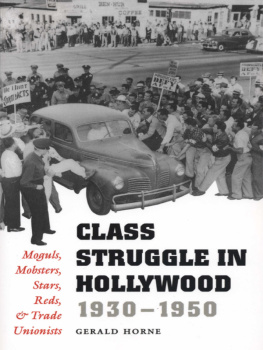Contents
Guide
Pagebreaks of the print version

Working in Hollywood
Working in Hollywood
How the Studio System Turned Creativity into Labor
Ronny Regev
University of North Carolina Press CHAPEL HILL
2018 The University of North Carolina Press
All rights reserved
Set in Espinosa Nova by Westchester Publishing Services
Manufactured in the United States of America
The University of North Carolina Press has been a member of the Green Press Initiative since 2003.
Library of Congress Cataloging-in-Publication Data
Names: Regev, Ronny, author.
Title: Working in Hollywood : how the studio system turned creativity into labor / Ronny Regev.
Description: Chapel Hill : University of North Carolina Press, [2018] | Includes bibliographical references and index.
Identifiers: LCCN 2017050787 | ISBN 9781469638294 (cloth : alk. paper) | ISBN 9781469636504 (pbk : alk. paper) | ISBN 9781469637068 (ebook)
Subjects: LCSH : Motion picture industryCaliforniaLos AngelesHistory20th century. | Motion picture industryCaliforniaLos AngelesEmployees.
Classification: LCC PN 1993.5. U 65 R 44 2018 | DDC 384/.80979494dc23 LC record available at https://lccn.loc.gov/2017050787
Cover illustration: Photograph of Katharine Hepburn checking her makeup in a park with several members of a film crew, during the making of Morning Glory , 1933. Used by permission of Photofest, Inc.
This work has drawn upon material originally published in Hollywood Works: How Creativity Became Labor in the Studio System, Enterprise & Society 17:3 (2016): 591617, published by Cambridge University Press, reproduced here with permission.
To my parents
Contents
Acknowledgments
I think if a man is an egotist and doesnt want his work touched I think that motion picture work is the wrong work for him to be engaged in; because motion pictures are necessarily collaborations.
DAVID O. SELZNICK
I have one thing in common with the Hollywood stars I write about; just like them I have acquired a large debt of gratitude to an extensive, unfailing support system. Indeed, so many wonderful people helped me throughout the past ten years that this book often felt like a collaborative effort.
Top billing goes to my academic mentors and advisers. I had the great privilege and fortune to study under the dedicated guidance of Daniel T. Rodgers. Dans advice, encouragement, and intellectual stimulation were instrumental in shaping this book and in shaping me as a scholar. With his incredible mind and gracious manner, he strengthened my knowledge and understating of history, showed me new ways to think of culture, and taught me, among many other important lessons, to look for the discourse behind every ism. Anson Rabinbach taught me that the cultural and even the pop cultural could also be intellectual. His endless knowledge and insightful comments about anything between Karl Marx and Groucho Marx were always thought-provoking, and I am deeply grateful to him for sharing them with me. Emily Thompson shared my Hollywood curiosity and helped expand my knowledge about it, while consistently providing a fresh take. Paul DiMaggio introduced me to the sociology of culture and inspired me to think about cultural production beyond the historical moment. Finally, T. J. Jackson Lears enriched my understanding of modernity and America. His ability to express complex historical phenomena in succinct and poetic language is a constant source of inspiration.
The opening credits to any history book must include archivists. This project took form in the special collections of the Margaret Herrick Library in Beverly Hills, and I am grateful to Barbara Hall, Louise Hilton, Jenny Romero, and the entire staff, who were always eager to help me find everything I needed. The dedicated personnel at the Oral History Division of Columbia University, the Louis B. Mayer Library at the American Film Institute in Los Angeles, the Museum of Modern Art Library in New York, the Special Collections at the Dorothy and Lewis B. Cullman Center of the New York Public Library for the Performing Arts, the Wisconsin Historical Society, and the Warner Bros. Archive at the University of Southern California were all equally helpful. I am also thankful to the archivists of the National Archives at College Park, who searched until they found the NLRB records I was so desperately looking for. I wish they had signed their e-mails so I could thank them individually.
I owe an immense amount of gratitude to the Princeton History Department. Throughout my years in Dickinson Hall, I have benefited from the tremendous generosity and wisdom of Margot Canaday, Dirk Hartog, Tera Hunter, Kevin Kruse, Yair Mintzker, Martha Sandweiss, Sean Wilentz, and Julian Zelizer, all of whom taught me a great deal. The Princeton University Graduate School provided the intellectual and material support for many years of uninterrupted research and learning. Stanley Katz, Paul DiMaggio, and Mindy Weinberg at the Center for Arts and Cultural Policy granted additional research funds as well as a stimulating forum in which to discuss culture and organizations. The American Studies Program at Princeton offered similar financial support and an engaging environment, and I would like to thank Dirk Hartog, William Gleason, Judith Ferszt, and Candice Kessel for including me in it. The professional support of William Jordan and Judith Hanson during some of the crucial writing stages was vitally important, and I cannot thank them enough. Elizabeth Bennett, Reagan Campbell, Minerva Fanfair, Lauren Kane, Doris Kratzer, Etta Recke, Barbara Leavey, Pamela Long, Debora Macy, Kristy Novak, Max Siles, Jaclyn Wasneski, and Carla Zimowsk were always very attentive and made the work experience efficient and pleasant in an unmatchable way.
The history department at Princeton is home to an extraordinary intellectual community, one that I am very honored to have been a part of. Many of the people I met in the graduate lounge in Dickinson Hall, the reading rooms in Firestone Library, and the seminar meetings of the Modern America Workshop have left their mark on my work. Specifically, I would like to thank Alex Bevilacqua, Sarah Coleman, Henry Cowles, Rohit De, Will Deringer, Yulia Frumer, Matt Growhoski, Justene Hill, Jennifer Jones, Zack Kagan-Guthrie, Kyrill Kunakhovich, Radha Kumar, Valeria Lopez Fadul, Kathryn McGarr, Elidor Mhilli, Paul Miles, Maribel Morey, Karam Nachar, Andrei Pesic, Helen Pfeifer, Suzanne Podhurst, Ben Schmidt, Margaret Schotte, and Sarah Seo for their thoughts and comments, and for making my time on campus friendly, exciting, and fun. More than anyone, Sarah Milov, always brilliant and razor-sharp, pushed me onward and upward. I cannot imagine a better companion to study American history with.
My fascination with history began thirty minutes north of Princeton, off a different New Jersey Turnpike exit. Remembering the wonderful years I spent at Rutgers University, I owe quite a bit to my professors at the history department in New Brunswick. Paul Clemens, David Foglesong, Ziva Galili, Bonnie Smith, and Virginia Yans all had a meaningful impact on my education as they taught me the basic skills a historian must have. Hilary A. Hallett deserves special recognition as she inspired me to think critically about Hollywood and introduced me to some of the sources any industry scholar should know.
Several exceptionally smart people graciously dedicated some of their precious time to read and comment on this manuscript or parts of it. Thank you so much, Ofer Ashkenazi, Eric Avila, Alec Dun, Chris Florio, Joe Fronczak, Dov Grohsgal, Doron Halutz, Caley Horan, Matt Karp, Beth Lew-Williams, Rosina Lozano, Charles McGovern, Andrei Pesic, Steven Ross, Moshe Sluhovsky, and Danny Walkowitz for every single useful comment. I would also like to thank Donna Haverty-Stacke and the Hunter College Labor and Working Class History Workshop Seminar, Yael Sternhell and the American Studies Seminar at Tel Aviv University, Sarah Milov and the Movement and Directions in Capitalism Seminar at the University of Virginia, Louis Warren, Emily Remus, Sarah Miller-Davenport, the Western Historical Association, the History of Capitalism Initiative at Cornell University, the Organization of American Historians, the Film and History Conference, and the Popular Culture Association / American Culture Association for providing engaging and productive forums in which to discuss my work.


